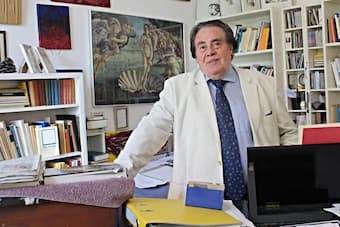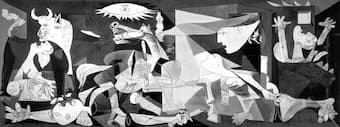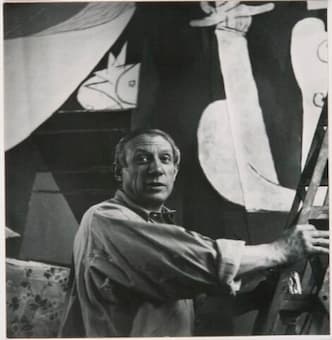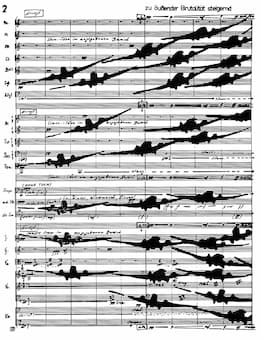
Walter Steffens (photo by Winkelhahn)
The German composer Walter Steffens has made a life’s work about being inspired by art. Over 100 of his compositions have artists’ works as their inspiration. Works by a wide range of artists including Picasso, Hieronymus Bosch, Edvard Munch, Bernard Aubertin, Marc Chagall, Peter Paul Rubens, Paul Klee, Emil Schumacher, and Gottfried Jäger and Karl Martin Holzhäuser have driven his compositions.
One of Picasso’s most evocative works was his 1937 antiwar painting Guernica. The work is in 3 colors: black, white, and grey, and is enormous, standing 3.49 meters (11 ft 5 in) tall and 7.76 meters (25 ft 6 in) across.

Picasso: Guernica (1937) (Madrid: Museo Reina Sofía)
Instead of the usual depictions of the horrors of war, dead bodies and smashing buildings, Picasso chose to focus on the actions: a mother and her dead child, an injured horse, and the Minotaur. The city of Guernica had been bombed by Germans on April 26, 1937. Picasso started working immediately, intending the work for display at the Paris International Art Exposition in the summer. He started in May with his initial sketches and completed the work at the end of June.
In depicting the agonized mother and the dead child, Picasso was taking images that for him always stood for motherhood and innocence and turned them into illustrations of destruction and violence. The horse is another victim of war – an innocent killed by others’ actions. The Minotaur, a symbol of truth for Picasso, stands against the violence that surrounds it.

Picasso in front of Guernica in his studio (May-June 1937) (Dora Maar)
The piece was displayed at the opening of the Paris International Art Exposition on 12 July 1937 where it remained on display until November. Between world tours, the work was placed at the Museum of Modern Art in New York, remaining there until 1981. Picasso had specified that the work was intended for Spain, but only after it became a democratic republic that held free elections. Free elections occurred in 1977 and a democratic constitution in 1978. Picasso did not live to see this, dying of congestive heart failure in 1973.
This work inspired Walter Steffens to his composition for viola soloist and orchestra, Guernica, Op. 32. Steffens called this a reflective approach to Picasso’s work. In writing about the work, Steffens recalled his own exposure to a bombing attack: “As a child I experienced bombing raids on Dortmund, I know the buzz of heavy bomber groups and the sudden horror of a low-flying attack. I try to recreate the moving events in the elegy for viola and orchestra with the aim of telling the drama of horror, fear, chaos, hopelessness, sadness and hope.” He starts with a quiet sound picture that gradually builds: the approach of the bombers and air raid siren places us immediately in the middle of the maelstrom. In the score, he paints the JU-52 bombers themselves.
Walter Steffens: Guernica, Op. 32 (Rainer Schmidt, viola; The Northwest German Philharmonic, Herford; Janos Kulka, cond.)

Steffens: Guernica score, page 2
The piece ends with the departure of the strike force – but in the middle Steffens captures the conflicting symbols in Picasso’s painting: the broken sword held in the same hand as a flower – peace and war in the same grasp. The woman on the right side of the painting in the burning house seeking help where there is none to be had, echoing the pose of the woman on the left side with her dead child.
The painting has always been a savage response to an inhumane act and its strength did much to bring the world’s attention to the Spanish Civil War. What the bombing started, the painting brought to a head. The war ended in 1939 and was called a ‘dress rehearsal’ for WWII. The Nationalists won the war and, under Francisco Franco, ruled Spain until 1975 when Franco died. It was only after his death that democracy was restored to Spain and the painting could take its rightful place in the country’s history.
For more of the best in classical music, sign up to our E-Newsletter




